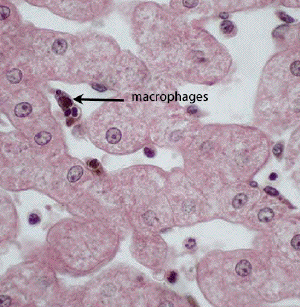Slide DMS061 [Liver]. The mononuclear phagocytic system (MPS) is a diffuse system of free and fixed phagocytic cells (macrophages). This system replaces the outdated "reticuloendothelial system" concept. The criteria for including a phagocytic cell in this system are: 1) origin from bone marrow precursor cell; 2) high level of phagocytic activity mediated by immunoglobulin (antibodies) and components of the serum complement system.
There is a dramatic example of one component of the MPS, the fixed macrophages (von Kupffer cells) in the liver. These cells line the blood sinusoids of the liver. These cells can be highlighted by intravenous injection of of India ink (carbon) particles 24 hours before sacrifice. Sections of the liver from this animal display many Kupffer cells literally engorged with phagocytosed carbon particles. This can be seen in Slide #60 contained in your slide boxes. While this preparation is useful for demonstrating the abundance, distribution, and obvious phagocytic capacity of these cells, the morphology of the macrophages is lost behind the carbon particles. This slide is another section of liver (not artifactually injected with carbon) and identify the macrophages as they naturally appear. They are found in the spaces (actually liver sinusoids) between the simple cuboidal epithelial cells that make up the liver parenchyma. The macrophages are easily identified by the greenish-brown particles (most likely remnants of phagocytosed red blood cells) found in their cytoplasm.
